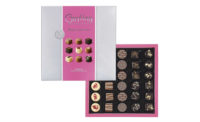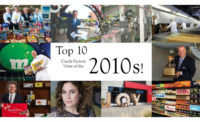
One of Torreblanca’s avant-garde sugar artistic pieces, as featured in his latest book, “Colección.”
For Paco Torreblanca, it’s all about simplicity, definition and balance. The world-renowned Catalonian pastry chef, one of the first to integrate avant-garde concepts into classical pastry and chocolate creations, insists on mastering the basics first … and experimenting afterwards.
Feted recently at Barry Callebaut’s Chocolate Academy in Chicago during the National Restaurant Show, Torreblanca took some time out to his schedule to sit down with Candy Industry and chat about chocolate, current trends in the industry and how he views his life’s work.
Asked to describe what chocolate means to him as an ingredient, Torreblanca sums it up succinctly: passion.
“It’s a unique item,” he explains. “You can taste it, but at the same time, you can make it into a beautiful artistic piece.”
Torreblanca credits Jean Millet, the famed M.O.F. (Meilleur Ouvrier de France) French pâtissier, for introducing him to the mysteries of chocolate.
“I was 12 years old when I began apprenticing with him in Paris,” Torreblanca says. “He taught me how to taste an orange, how to taste chocolate. Tasting chocolate is like being a sommelier; you’re evaluating all the flavors in chocolate. It’s not as simple as it sounds.”
Torreblanca’s apprenticeship flourished under Millet’s tutelage, and he eventually became a master of the craft. Upon returning to his family home in Alicante, Spain, in 1978, he opened his own shop, Totel, at the age of 25.

Renowned pastry chef and chocolatier Paco Torreblanca puts the finishing touches on a sugar artistic piece.
He was one of the first to use saffron in the production of chocolates and candies.
The Spanish master smiles when he recalls what kind of reaction one critic penned: “He wrote that there’s this crazy person who is wasting saffron by using it in chocolate.”
Since then, Torreblanca continuously has pushed the envelope, defying convention by experimenting with flavors, textures, shapes and even expectations.
For example, at the Barry Callebaut reception in Chicago in late May, Torreblanca presented a chocolate truffle using actual white truffles in the ganache, imparting an earthy yet subtle taste that playfully puns the chocolate’s description.
“We tend to think of chocolate as only being sweet, a candy,” he says. “The Aztecs and Mayans used it with salty applications. Take the onion, which can be sweet. When you sauté it and pass it through water, it becomes a sweet ingredient. At that point, you only taste the sweetness.”
Nevertheless, Torreblanca warns against being overzealous in the creative process.
“One should never forget what was learned from classic technique,” he says. “Classic techniques permit us to advance.”
He notes that many chefs combine ingredients to provoke reactions. Such provocation isn’t always a good thing, Torreblanca says.
“One can provoke, but you need to use common sense,” he asserts.

Torreblanca frolics with students during a 2007 competition.
“I infuse the tea in cold water and then let it stand for a day,” he explains. “You get cleaner and more subtle flavors as a result.”
To Torreblanca, taste and flavor always come first. He extols the single-origin chocolates that have come into play these days, comparing them to fine wines, each resplendent in their own terroir. [Editor’s note: Terroir is a French term most often used in reference to a wine’s agricultural origins. Loosely translated as a “sense of place,” terroir encompasses effects the land has on a product.]
These chocolates, he adds, open up further creative nuances, such as the blending of distinct single-origin chocolates to attain certain taste profiles.
“I love the idea of blending single-origin chocolates,” Torreblanca says. “As professionals, we should understand the many flavors chocolates can offer up.”
Before artistry, flavor comes first, he points out. The key is putting both things together.
“One can make a beautiful sculpture, but you haven’t succeeded as a professional unless you can also make a good classic chocolate,” Torreblanca affirms. “One needs to learn the basics very well.”
It’s one reason why so many pastry professionals become extraordinary chocolatiers, he adds. Not only does apâtissier need to master basic technique, but he has to be very precise. It’s a trait that comes in handy in chocolate and confections.
“Confectionery technique requires one to be exact,” Torreblanca says. “For a ganache to be well-balanced, there has to be equilibrium in the recipe. If you’ve worked in pastry, you understand the need to be very exact, very precise.”
That need to be precise is why - unlike some artisanal chocolatiers - Torreblanca has embraced technology to produce everything from confections to cakes. Thus, the Spanish master doesn’t shy away from using enrobers, vacuum mixers or even one-shot depositors to attain perfection.

Students at Barry Callebaut's Chocolate Academy in Chicago plate desserts and chocolates during a reception held in honor of Torreblanca in mid-May.
In addition to supplying high-end shops, restaurants, hotels and other outlets with such desserts, the company will offer customers the option of creating their own recipes under Torreblanca’s guidance at the plant’s development lab.
Torreblanca also has set into motion a concept featuring stand-alone small shops featuring his mix of confections and pastries. The first one opened in Alicante last fall, and plans call for others to debut in Barcelona, Malaga and Sevilla. He also intends to open up “the best dessert shop in the world” with Sergi Arola, one of Spain’s most extraordinary young chefs.
At the same time, Torreblanca continues to author books - he’s written three solo and collaborated on two others - while teaching and mentoring. His two sons work side by side, one managing production, the other handling the business end.
“It’s critical to pass on the knowledge to young people so that they and the profession can continue to grow,” he says.
As for his source of inspiration, thechocolatero cites Picasso.
“Yes, at the end of the day you can look at the sea and be inspired,” he says. “But as Picasso would say, the inspiration comes when you are working. Then, everything is made, everything is ready, you just have to put all the elements in the right place.”
And Torreblanca does seem to have quite a knack for doing just that.
For more information on Paco Torreblanca, visitwww.torreblanca.net.



